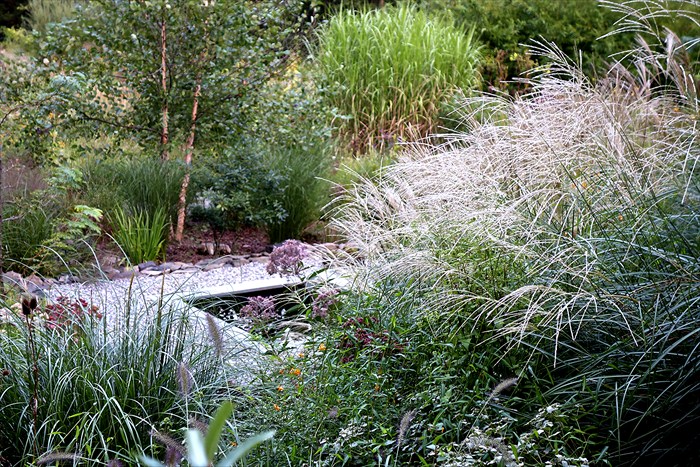Think jangly, heterogeneous confusion of a riot ...

I'm trying to learn how to use a new camera, so last week I took a twilight stroll to try it out in low light. The camera is a compact Sony Cybershot DSC-RX100. I've been very disappointed with my Canon Rebel DSLR for years; the Sony has received rave reviews and, though it doesn't have interchangeable lenses, it does have an image sensor considerably larger than the Canon's, and therefore has more light-gathering power. It's technically a complex camera so a lot of experimentation is in order (i.e., I need to learn the controls). It will never do what a good DSLR with good lenses would do, but perhaps it's good enough for my uses.As my first challenge, I tried to show the full expanse of the garden. This is hard to do. In fact, I've never taken a successful picture of the whole garden though the photo above is better than most. The dark tree limbs and shrubs in the foreground frame the view of the distant line of trees, creating a sense of perspective and helping define the volume of the garden in a spatial sense. This photo was taken at 6:57 pm, so the garden is almost completely in shade, while the distant tree tops show the last of the sun's rays, emphasizing the sense of distance and the spatial void in which the garden exists. Too bad you can't see any detail or make out the inner structure of the garden.Zooming in to that mass of Joe Pye Weed in the center left, I was surprised to see how saturated the colors appear ...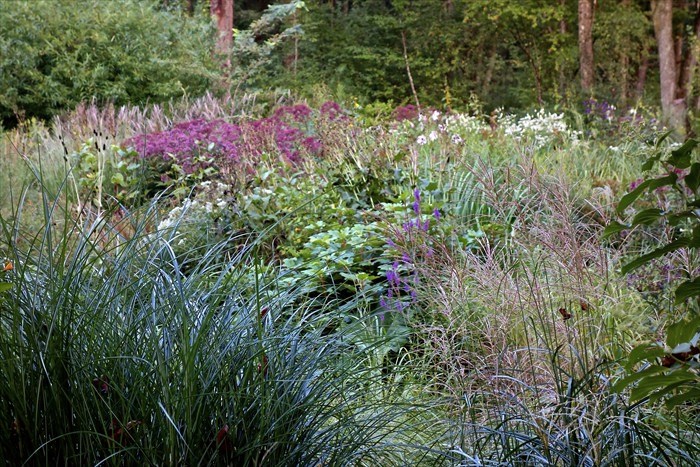 ... my assumption is that, in dim light, the automatic setting I used set the lens aperture wide open to gather more light, causing the color saturation. The wide aperture would also account for the lack of sharp focus.Moving to the left, from the center of the garden to the area of the reflecting pool on the north end of the house (into even shadier territory), the colors appear to change.
... my assumption is that, in dim light, the automatic setting I used set the lens aperture wide open to gather more light, causing the color saturation. The wide aperture would also account for the lack of sharp focus.Moving to the left, from the center of the garden to the area of the reflecting pool on the north end of the house (into even shadier territory), the colors appear to change.
The pale mauve of the Joe Pye Weed intermingled with miscanthus below, interestingly, is much less saturated. My guess is that the subject's nearness to the camera lens and localized lighting conditions capture a truer color (incidentally, the bit of silvery Pycnantheum muticum sparkling on the right tells me I should add more of this extraordinary wilding to the interstices of this tumble-down composition for next year.).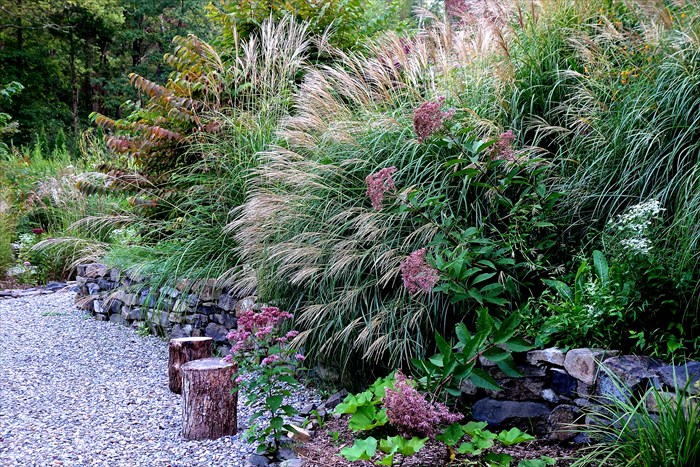 It's probably obvious to anyone who's read this blog that I have a preference for fullness verging on chaos. A lot is going on in the garden, and in the photographs I take of it. I often push the composition right to the edge of disorder, but (I hope) retain what Thomas Rainer refers to as legibility. The next photo is the first example--a Viburnum nudum 'Winterthur' just starting to take on hues of red and a red Sanguisorba to its right perhaps pull together through color, definitely not similar forms (though on second thought I do see similarities in the branching patterns of the support structures) ...
It's probably obvious to anyone who's read this blog that I have a preference for fullness verging on chaos. A lot is going on in the garden, and in the photographs I take of it. I often push the composition right to the edge of disorder, but (I hope) retain what Thomas Rainer refers to as legibility. The next photo is the first example--a Viburnum nudum 'Winterthur' just starting to take on hues of red and a red Sanguisorba to its right perhaps pull together through color, definitely not similar forms (though on second thought I do see similarities in the branching patterns of the support structures) ...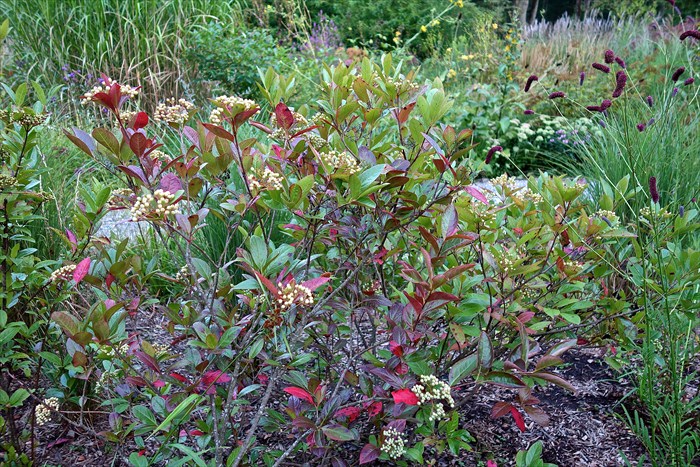 ... then in the next photo the color of the dangly Sanguisorba flowers clashes with the background vegetation. Think jangly, heterogeneous confusion of a riot, as if the parts want to fly apart. Change being the essence of this garden, in another week or two, as the autumn colors start to predominate, this visual cacophony will be harmonized.
... then in the next photo the color of the dangly Sanguisorba flowers clashes with the background vegetation. Think jangly, heterogeneous confusion of a riot, as if the parts want to fly apart. Change being the essence of this garden, in another week or two, as the autumn colors start to predominate, this visual cacophony will be harmonized. Looking up the bank to the house, the camera's light-gathering capability shows a lot of color and detail, though again the focus leaves something to be desired. (Focus is a problem with all these low light photos; I should have used a tripod.) The color of the fading Joe Pye Weed is rendered rather faithfully, as are the bruised purples and blues of the Lespedeza 'Gibraltar' and asters behind. The resolution isn't fine enough to show you the yellows are Patrinia scabiosifolia, not golden rod. But the overall effect of the bank planting retains the imagery of roiling ocean waves typical of the bank planting at this time of year, as the grasses come into bloom.
Looking up the bank to the house, the camera's light-gathering capability shows a lot of color and detail, though again the focus leaves something to be desired. (Focus is a problem with all these low light photos; I should have used a tripod.) The color of the fading Joe Pye Weed is rendered rather faithfully, as are the bruised purples and blues of the Lespedeza 'Gibraltar' and asters behind. The resolution isn't fine enough to show you the yellows are Patrinia scabiosifolia, not golden rod. But the overall effect of the bank planting retains the imagery of roiling ocean waves typical of the bank planting at this time of year, as the grasses come into bloom.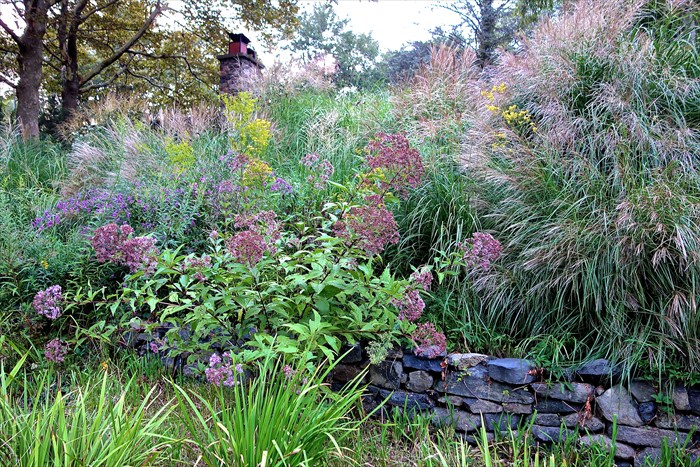 I'm a sucker for Sanguisorba. I have them everywhere and want more. I just need to remember to cut some in early summer so they don't get too tall and flop into the paths. This one, perhaps because it's in relatively dryer soil on the well drained bank, is holding its form well.
I'm a sucker for Sanguisorba. I have them everywhere and want more. I just need to remember to cut some in early summer so they don't get too tall and flop into the paths. This one, perhaps because it's in relatively dryer soil on the well drained bank, is holding its form well.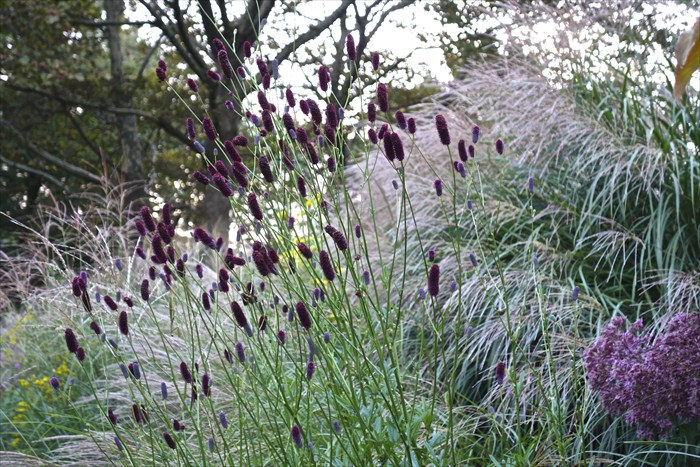 Here again are the in-your-face colors. Strange I say this because I've been thinking the garden is going through a bland, colorless time. But the new camera brings out the colors even in the browned seed heads of Filipendula rubra 'Venusta' ... as well as the leaden browns in the dying columns of Silphium perfoliatum in the far left.
Here again are the in-your-face colors. Strange I say this because I've been thinking the garden is going through a bland, colorless time. But the new camera brings out the colors even in the browned seed heads of Filipendula rubra 'Venusta' ... as well as the leaden browns in the dying columns of Silphium perfoliatum in the far left.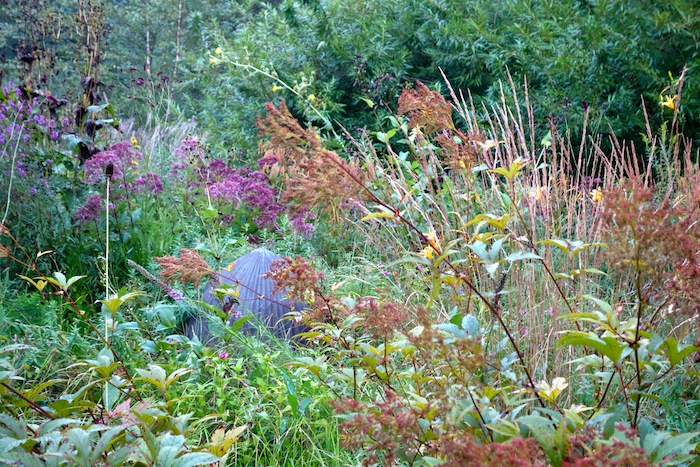 In the next photos you can see the saturated colors of summer are beginning to fade into rusts, blacks and browns, and fawns of autumn, just a hint here and there. In some images, an obvious change to fall ...
In the next photos you can see the saturated colors of summer are beginning to fade into rusts, blacks and browns, and fawns of autumn, just a hint here and there. In some images, an obvious change to fall ...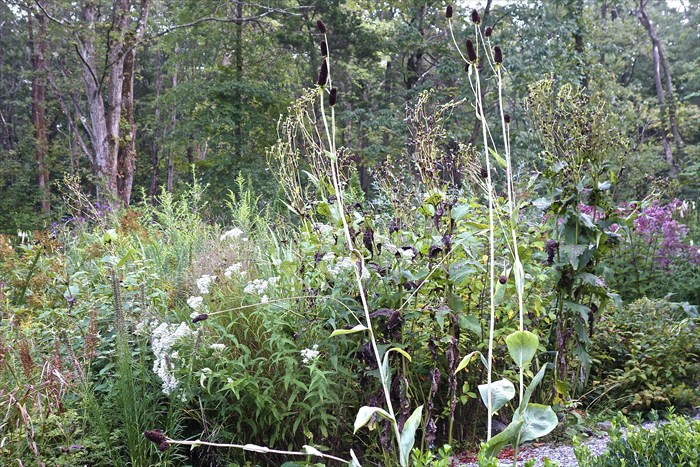 ... in others, the colors remain bright. It's a mixed bag at present. Below: Filipendula, Rudbeckia maxima, Calamagrostis A. 'Karl Foerester' veering off in every direction ...
... in others, the colors remain bright. It's a mixed bag at present. Below: Filipendula, Rudbeckia maxima, Calamagrostis A. 'Karl Foerester' veering off in every direction ...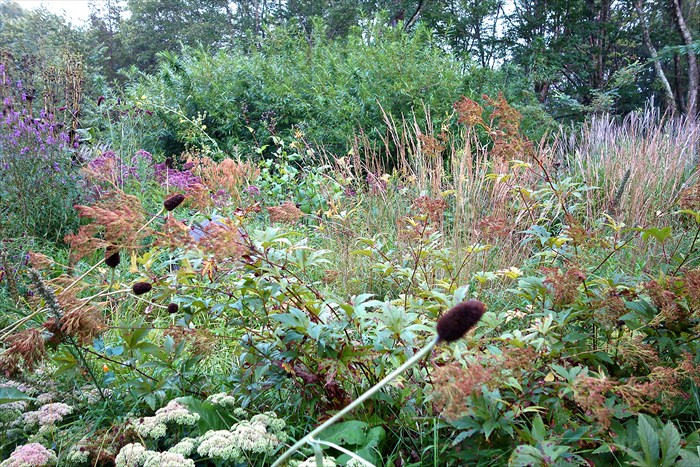 The white flowers on the right--Eupatorium perfoliatum ...
The white flowers on the right--Eupatorium perfoliatum ...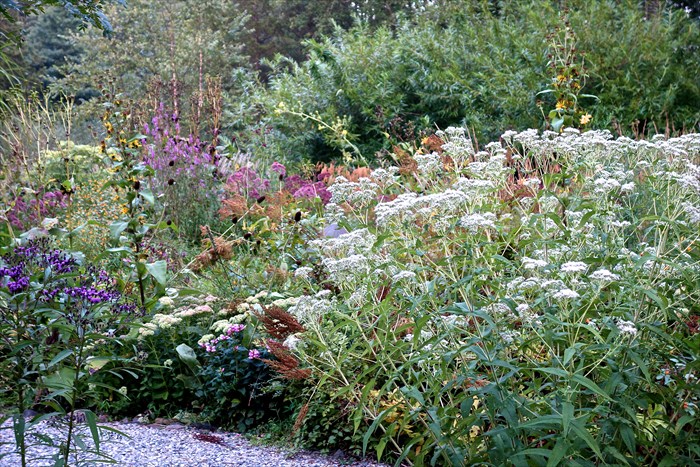 Box, Rudbeckia maxima, Hydrangea quercifolia, bunches of tall, rapidly fading Silphium perfoliatum ... if you don't already know the structure of this planting, I wonder what you can make out looking at the photo. Again, pushing the edge of chaos, presenting a puzzle? This place gives me a good feeling. Hard to know why. It just belongs here. With me.
Box, Rudbeckia maxima, Hydrangea quercifolia, bunches of tall, rapidly fading Silphium perfoliatum ... if you don't already know the structure of this planting, I wonder what you can make out looking at the photo. Again, pushing the edge of chaos, presenting a puzzle? This place gives me a good feeling. Hard to know why. It just belongs here. With me.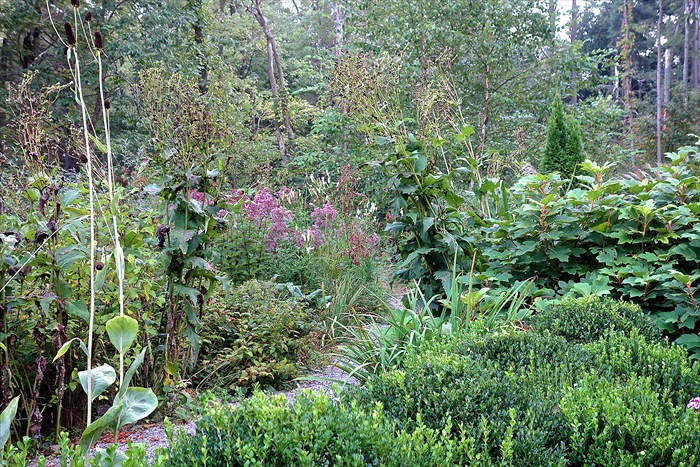 Need I say Rudbeckia maxima again? This time the seed heads are in focus but the Button Bush behind isn't. I know this is because the wide aperature of the lens creates a very shallow depth of field. That's my problem, really, controlling depth of field, thus range of focus, in such low light.
Need I say Rudbeckia maxima again? This time the seed heads are in focus but the Button Bush behind isn't. I know this is because the wide aperature of the lens creates a very shallow depth of field. That's my problem, really, controlling depth of field, thus range of focus, in such low light.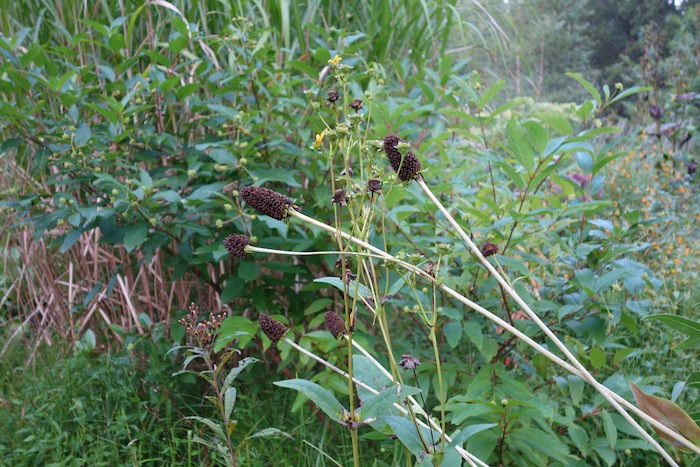 Rudbeckia 'Henry Eilers' and one blue spire of Lobelia syphilitica ...
Rudbeckia 'Henry Eilers' and one blue spire of Lobelia syphilitica ...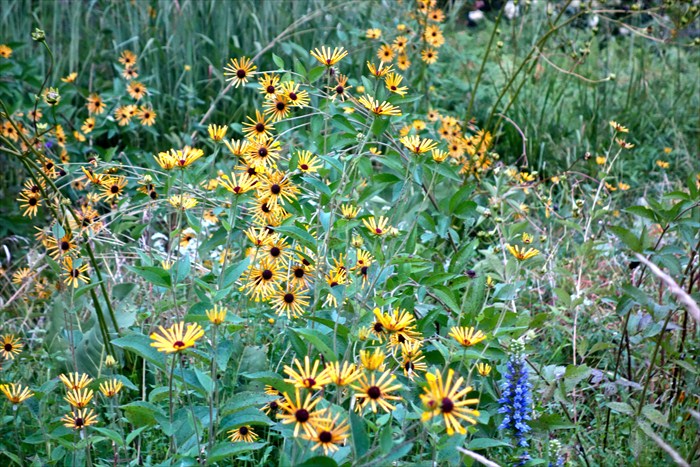 The path heading around to the circle of red logs, with Vernonia, the skeleton of Teasel, many miscanthus ...
The path heading around to the circle of red logs, with Vernonia, the skeleton of Teasel, many miscanthus ...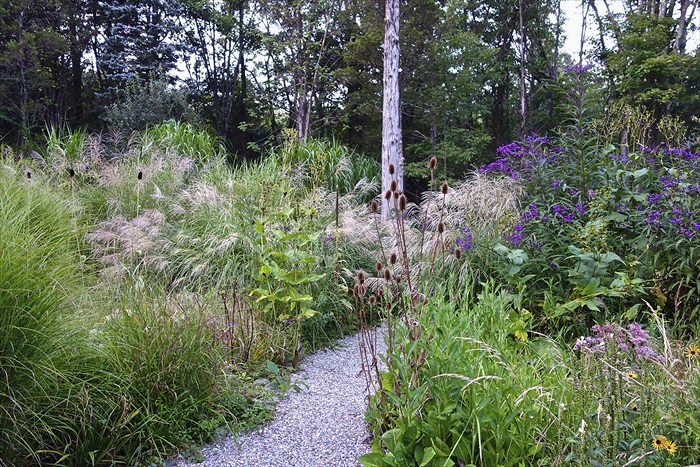 The textures and shapes are what keep this area interesting now, after the flowers have faded and before the autumn colors arrive. You can't see them in the photo above, but you can below.
The textures and shapes are what keep this area interesting now, after the flowers have faded and before the autumn colors arrive. You can't see them in the photo above, but you can below.
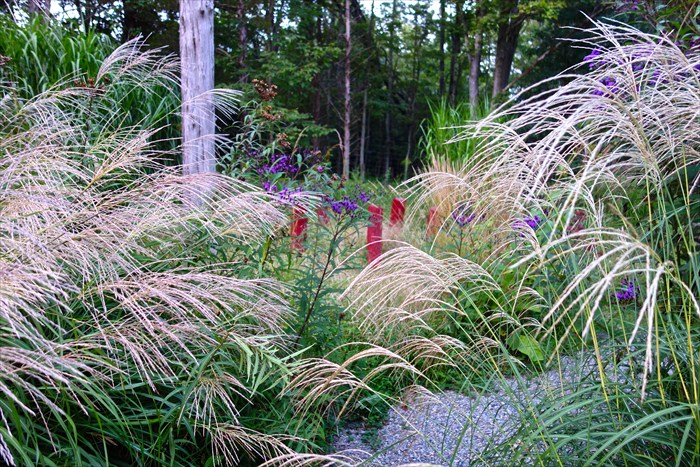 At the back two Wave Hill chairs sit empty amid the celebration of tall Inula racemosa 'Sonnerspeer', Miscanthus purpurescens, Silphium perfoliatum, Joe Pye Weed ... The resolution in these photos is sufficient to make a satisfying aesthetic effect but I'd like more sharpness.
At the back two Wave Hill chairs sit empty amid the celebration of tall Inula racemosa 'Sonnerspeer', Miscanthus purpurescens, Silphium perfoliatum, Joe Pye Weed ... The resolution in these photos is sufficient to make a satisfying aesthetic effect but I'd like more sharpness.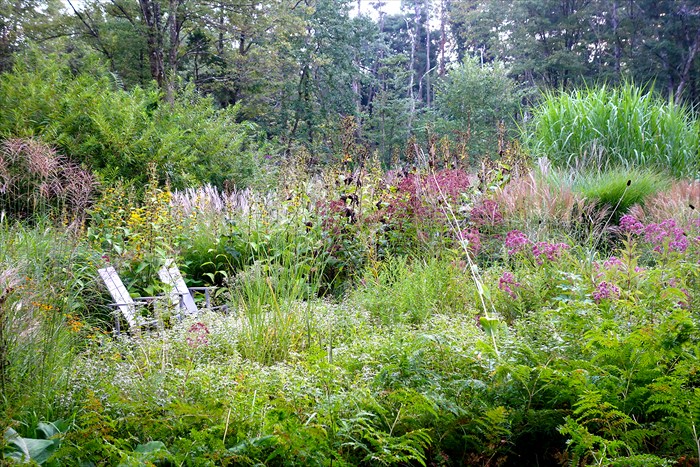 So I have to keep at this, read the manual, perhaps? Practice and see how these posts change over time.A view up to the house. The reflecting pool is straight through though you'd never know it. This area will become a riot of color as autumn progresses. (Autumn color is very forgiving of poor camerawork.)
So I have to keep at this, read the manual, perhaps? Practice and see how these posts change over time.A view up to the house. The reflecting pool is straight through though you'd never know it. This area will become a riot of color as autumn progresses. (Autumn color is very forgiving of poor camerawork.)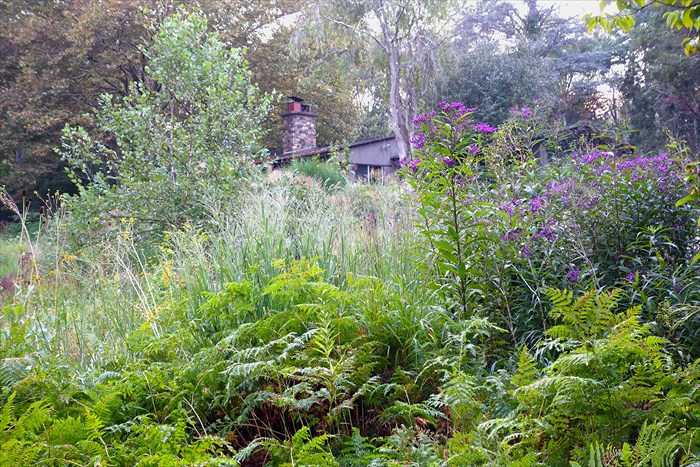 My little sitting area buried in hydrangeas. The tawny grass at center right is native self-seeded Indian grass (Sorghastrum nutans). Another bit of the original landscape growing through. (And what is the original landscape? The land before I started the garden? The open field that was here before the Howeths built the house in 1965? The orchards that probably grew here in the late nineteenth century? The centuries of native American habitation before the Europeans came?) It's all quite mysterious, trying to say what is real, what is original, what is authentic ... it almost makes you think everything is, or nothing is.
My little sitting area buried in hydrangeas. The tawny grass at center right is native self-seeded Indian grass (Sorghastrum nutans). Another bit of the original landscape growing through. (And what is the original landscape? The land before I started the garden? The open field that was here before the Howeths built the house in 1965? The orchards that probably grew here in the late nineteenth century? The centuries of native American habitation before the Europeans came?) It's all quite mysterious, trying to say what is real, what is original, what is authentic ... it almost makes you think everything is, or nothing is.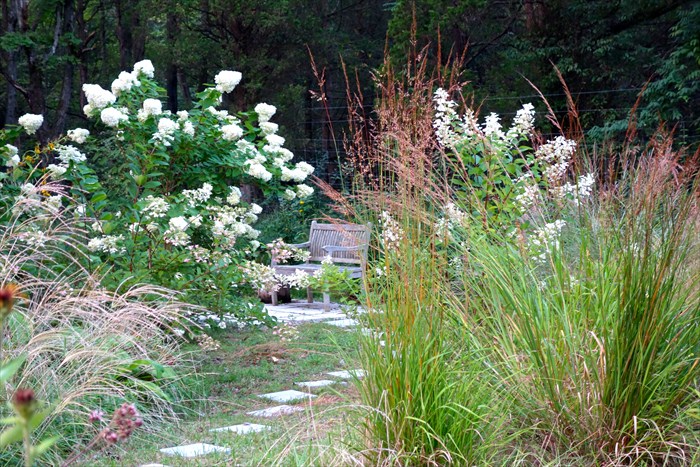 So what am I trying to capture with my learning camera work?The truth? Or just hydrangeas?
So what am I trying to capture with my learning camera work?The truth? Or just hydrangeas?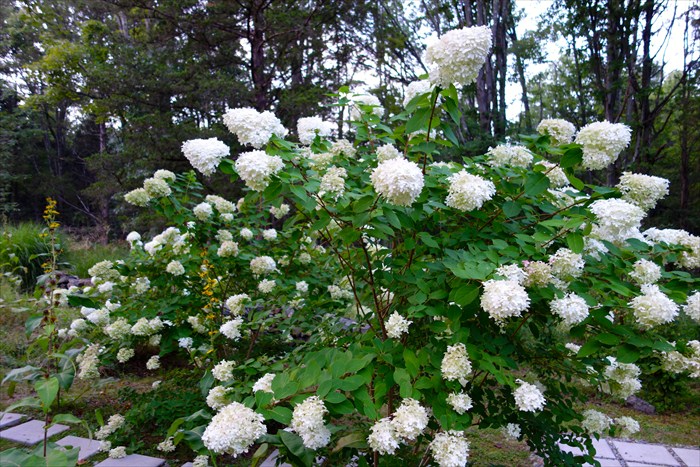 This mysterious corridor at the back of the garden? Why does it appeal? Why do I call it mysterious?
This mysterious corridor at the back of the garden? Why does it appeal? Why do I call it mysterious?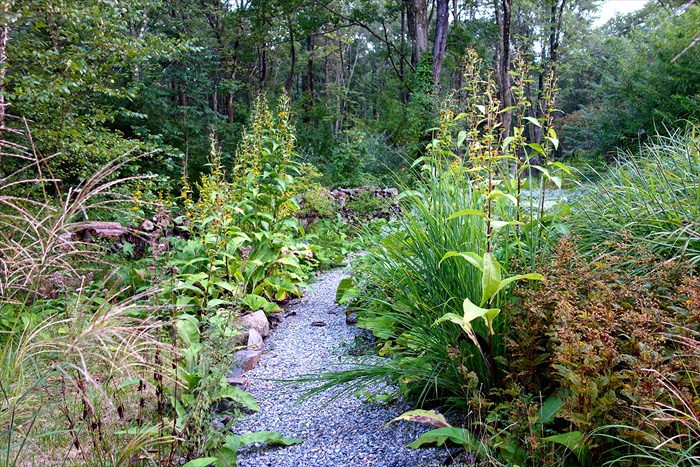
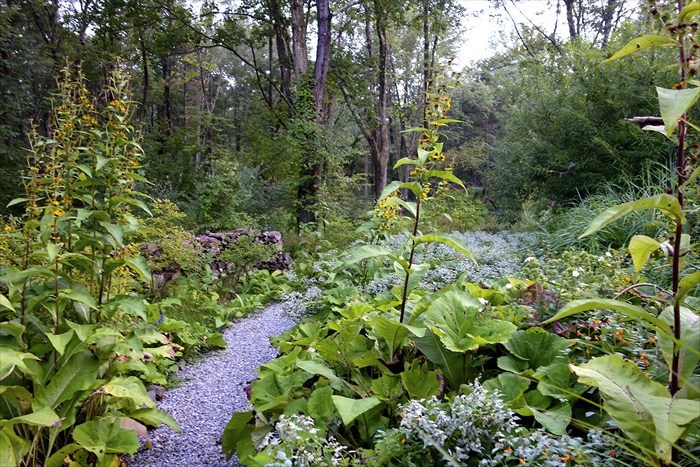 Plains of Pycnanthemum muticum with leaning towers of Inula? Is this just a visual diversion or does it "hook" into my consciousness, my being at some deep level?
Plains of Pycnanthemum muticum with leaning towers of Inula? Is this just a visual diversion or does it "hook" into my consciousness, my being at some deep level?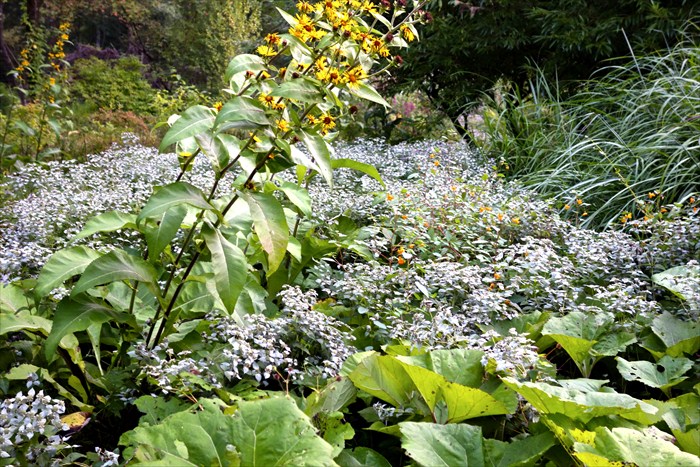 Magic? Visual poetry?
Magic? Visual poetry?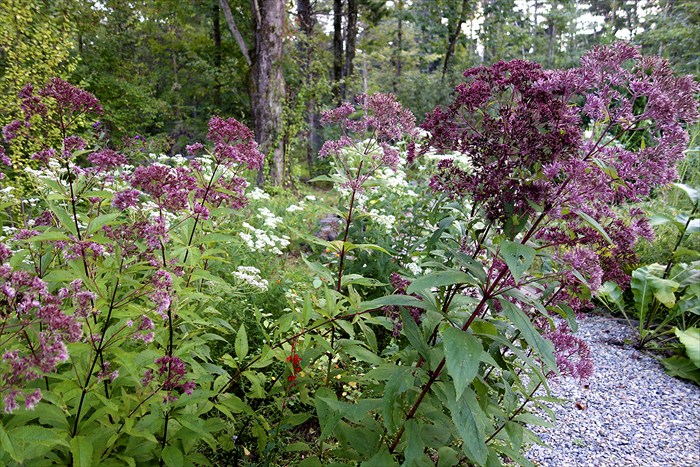
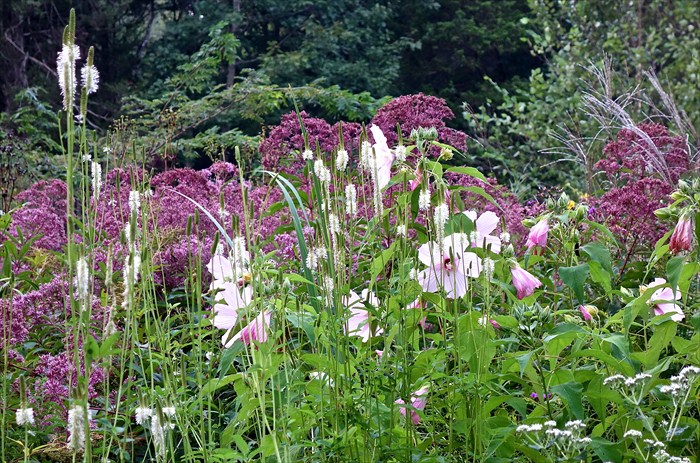 Phil reading the Sunday Times? A quotidian activity, but the context seems to lend the act a more significant meaning.
Phil reading the Sunday Times? A quotidian activity, but the context seems to lend the act a more significant meaning. Control?
Control?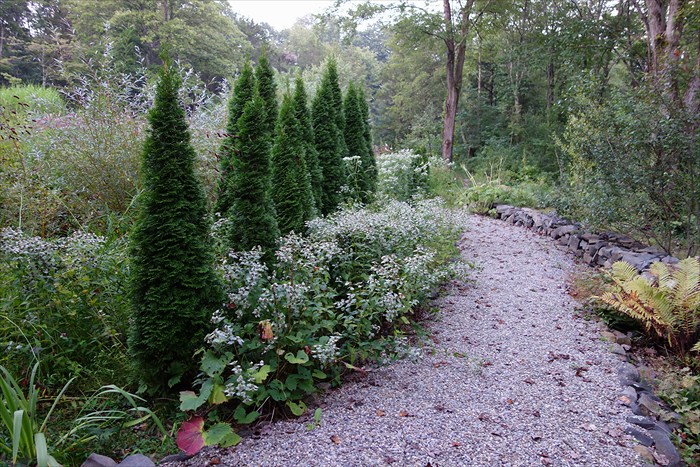 Incipient chaos?
Incipient chaos?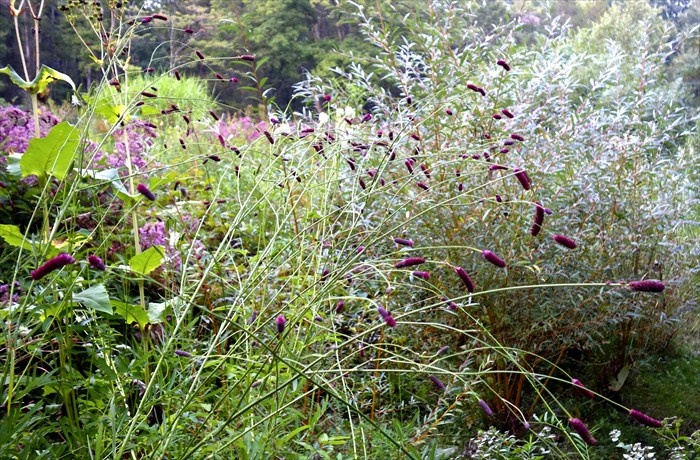 A sense of fullness?
A sense of fullness?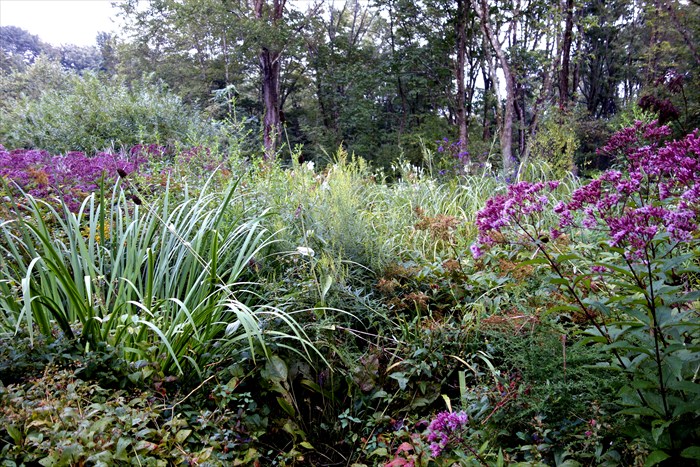 Complexity?
Complexity?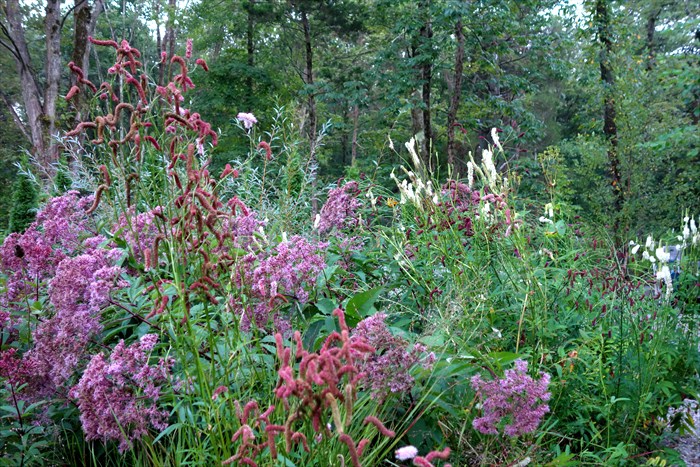 Words fail. Yes they do.
Words fail. Yes they do.
